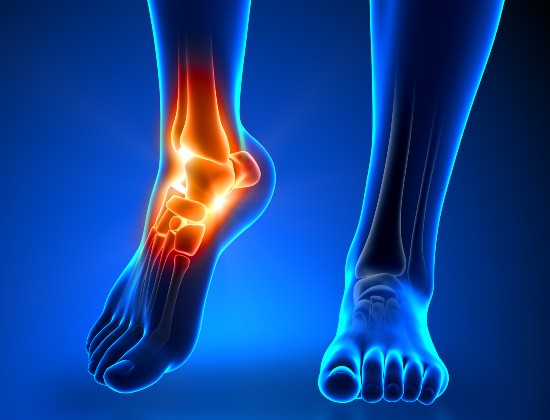Ankle arthritis
The ankle joint is at the bottom of the leg between the tibia, or shin bone, and the ankle (talus) bone in the foot. Ankle arthritis, or osteoarthritis, is a condition where the smooth cartilage lining of the bones inside the joint, which allows normal smooth motion between the bones, becomes worn and gradually causes friction between the bones when you move.
What causes it?
You are more likely to have ankle arthritis if you have:
- Had a previous fracture or bad ankle sprain
- Gout or arthritis in other areas of your body
- A bleeding disorder such as haemophilia
- An infection in your ankle
What are the symptoms?
Symptoms include pain around the ankle, especially when it’s moving, caused by roughening of the joint. Initially the foot or ankle can be quite swollen as the joint lining become inflamed and warmer to joint. Putting the foot into a normal shoe can be difficult and pain can become progressively worse, even when resting. In severe cases the ankle can become deformed, making walking difficult.
Can it become worse?
People often live with the symptoms for many years before seeking medical advice. If you decide not to see your doctor, the problem will tend to become worse, usually slowly. Pain and stiffness will usually increase, making walking gradually more difficult and weight-bearing exercise extremely difficult. The condition can be treated at any stage; early surgery can potentially preserve the joint with a joint replacement whereas later surgery may require ankle fusion.
How is it diagnosed?
As well as a medical examination and discussion of your symptoms, X-rays and MRI scans can show deterioration of the ankle joint.
How is it treated?
Non-operative treatment:
- Using a brace or supportive boots to stabilise your ankle, rocker-bottom shoes or cushioned shoes to absorb impact on walking
- Your doctor may also suggest painkillers or anti-inflammatory tablets
- You may be offered steroid injections to reduce pain
Surgery:
- If the pain interferes with your daily life or affects your sleep, despite taking painkillers and anti-inflammatory medication, your doctor may suggest ankle arthroscopy to tidy up the joint and restore movement (debridement)
- Other options include ankle joint replacement or ankle fusion surgery, which stiffens your ankle joint permanently
Is joint replacement better than joint fusion?
Although the joint is permanently stiffened in ankle fusion surgery, it’s fixed in a position that allows people to maintain a very active lifestyle, even jogging or running. Different shoe styles can make walking easier after a fusion. Joint replacement aims to maintain movement; however, it’s less predictable in its long-term outcome, especially in active younger people. As technology and design improves, the success of ankle replacements will continue to grow.
Important: This information is only a guideline to help you understand your treatment and what to expect. Everyone is different and your rehabilitation may be quicker or slower than other people’s. Please contact us for advice if you’re worried about any aspect of your health or recovery.


